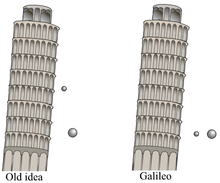
Back Galileo se eksperiment met die Skewe Toring van Pisa Afrikaans تجربة جاليلو على برج بيزا المائل Arabic Experimento de Galileo en la torre de Pisa Spanish ניסוי מגדל פיזה של גלילאו HE गैलिलियो का झुकी मीनार प्रयोग Hindi Esperimento di Galileo sulla caduta dei gravi dalla torre di Pisa Italian ガリレオによるピサの斜塔実験 Japanese Эксперименты Галилея по падению тел Russian Дослід Галілея з падінням тіл Ukrainian

Between 1589 and 1592,[1] the Italian scientist Galileo Galilei (then professor of mathematics at the University of Pisa) is said to have dropped "unequal weights of the same material" from the Leaning Tower of Pisa to demonstrate that their time of descent was independent of their mass, according to a biography by Galileo's pupil Vincenzo Viviani, composed in 1654 and published in 1717.[2][3]: 19–21 [4][5] The basic premise had already been demonstrated by Italian experimenters a few decades earlier.
According to the story, Galileo discovered through this experiment that the objects fell with the same acceleration, proving his prediction true, while at the same time disproving Aristotle's theory of gravity (which states that objects fall at speed proportional to their mass). Most historians consider it to have been a thought experiment rather than a physical test.[6]
- ^ Some contemporary sources speculate about the exact date; e.g. Rachel Hilliam gives 1591 (Galileo Galilei: Father of Modern Science, The Rosen Publishing Group, 2005, p. 101).
- ^ Vincenzo Viviani (1717), Racconto istorico della vita di Galileo Galilei, p. 606: [...dimostrando ciò con replicate esperienze, fatte dall'altezza del Campanile di Pisa con l'intervento delli altri lettori e filosofi e di tutta la scolaresca... [...Galileo showed this [all bodies, whatever their weights, fall with equal speeds] by repeated experiments made from the height of the Leaning Tower of Pisa in the presence of other professors and all the students...].
- ^ Drake, Stillman (2003). Galileo at Work: His Scientific Biography (Facsim. ed.). Mineola (N.Y.): Dover publ. ISBN 9780486495422.
- ^ "Sci Tech : Science history: setting the record straight". The Hindu. June 30, 2005. Archived from the original on November 2, 2005. Retrieved May 5, 2009.
- ^ Vincenzo Viviani on museo galileo
- ^ "El experimento más famoso de Galileo probablemente nunca tuvo lugar". The Conversation. May 16, 2019. Retrieved May 17, 2019.